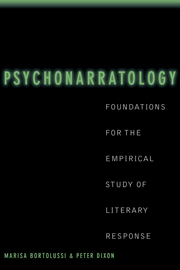Book contents
7 - Represented Speech and Thought
Published online by Cambridge University Press: 28 July 2009
Summary
Literary narratives in which only events are summarized are virtually nonexistent. In most narratives there are characters who speak and think; in fact, casual observation indicates that in many literary texts well over half of the words consist of dialogue or representations of character thoughts. The speech and thought of characters can be used for a wide range of purposes: It can advance the plot, provide direct information about the speaking characters and their reactions as well as indirect information about other characters, present the reader with a variety of perspectives or viewpoints, convey attitudes and judgments of the narrator, and communicate thematic content. Thus, the category of speech and thought intersects with those of narrator, plot, character, and focalization, and it is often impossible to speak of one without alluding to the others.
Because of the enormous variety of styles and techniques available to authors for the representation of speech and thought, the study of its forms and uses is a complex problem that, in our view, is still not fully understood. Within the fields of literary scholarship and linguistics, however, there have been a variety of important advances including typologies of speech and thought representation styles. Literary scholars in particular have been sensitive to the crucial issue of the effect of speech and thought representation styles on readers; however, they have been unable to frame hypotheses about reader constructions beyond the limits of purely speculative intuitions.
- Type
- Chapter
- Information
- PsychonarratologyFoundations for the Empirical Study of Literary Response, pp. 200 - 236Publisher: Cambridge University PressPrint publication year: 2002



